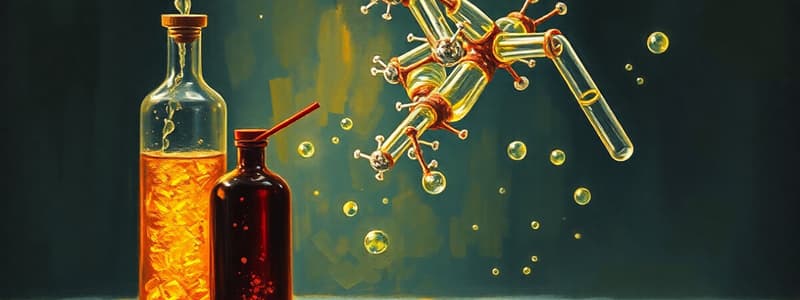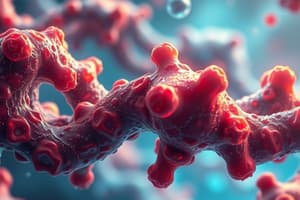Podcast
Questions and Answers
What happens to an enzyme when it is denatured?
What happens to an enzyme when it is denatured?
- It retains its original shape.
- It increases its reaction rate.
- It may unfold and lose its function. (correct)
- It becomes more efficient.
Which of the following factors can lead to enzyme denaturation?
Which of the following factors can lead to enzyme denaturation?
- Decrease in pressure.
- Changes in temperature. (correct)
- Addition of coenzymes.
- Increase in substrate concentration.
How does an increase in temperature affect enzyme activity up to a certain point?
How does an increase in temperature affect enzyme activity up to a certain point?
- Enzyme activity stops entirely.
- Enzyme activity increases due to more collisions. (correct)
- Enzyme activity decreases due to denaturation.
- Enzyme activity fluctuates unpredictably.
What is the effect of extreme pH changes on enzymes?
What is the effect of extreme pH changes on enzymes?
Why do pepsin and trypsin exhibit different optimal pH values?
Why do pepsin and trypsin exhibit different optimal pH values?
What occurs when the temperature exceeds an enzyme's optimal level?
What occurs when the temperature exceeds an enzyme's optimal level?
Which ion is NOT typically implicated in enzyme denaturation?
Which ion is NOT typically implicated in enzyme denaturation?
How does a denatured enzyme affect the rate of a biochemical reaction?
How does a denatured enzyme affect the rate of a biochemical reaction?
What is the optimal pH for pepsin to function effectively?
What is the optimal pH for pepsin to function effectively?
What happens when a substrate can produce two different products through different enzymes?
What happens when a substrate can produce two different products through different enzymes?
Why is enzyme specificity important in metabolic pathways?
Why is enzyme specificity important in metabolic pathways?
What type of regulation occurs when a cell no longer needs the product from an enzyme?
What type of regulation occurs when a cell no longer needs the product from an enzyme?
What does competitive inhibition involve?
What does competitive inhibition involve?
How can enzyme concentrations be regulated within a cell?
How can enzyme concentrations be regulated within a cell?
What role do proteins play in the metabolism of cells?
What role do proteins play in the metabolism of cells?
Which of the following statements about enzyme production is accurate?
Which of the following statements about enzyme production is accurate?
Which vitamin is associated with the coenzyme NAD+?
Which vitamin is associated with the coenzyme NAD+?
What is the function of NADH in cellular respiration?
What is the function of NADH in cellular respiration?
Which of the following coenzymes is used in photosynthesis?
Which of the following coenzymes is used in photosynthesis?
What does FAD convert into after being reduced?
What does FAD convert into after being reduced?
What is the result of the reaction NAD+ + 2H?
What is the result of the reaction NAD+ + 2H?
What role does NADPH play in photosynthesis?
What role does NADPH play in photosynthesis?
Which vitamin corresponds to Coenzyme A?
Which vitamin corresponds to Coenzyme A?
Which of the following accurately describes FAD?
Which of the following accurately describes FAD?
What is the primary function of enzymes in biochemical reactions?
What is the primary function of enzymes in biochemical reactions?
What characterizes enzymes in terms of specificity?
What characterizes enzymes in terms of specificity?
What happens at the active site of an enzyme?
What happens at the active site of an enzyme?
What does the Induced Fit Theory propose about the interaction between an enzyme and its substrate?
What does the Induced Fit Theory propose about the interaction between an enzyme and its substrate?
Why are enzymes considered reusable in chemical reactions?
Why are enzymes considered reusable in chemical reactions?
How are enzymes typically named?
How are enzymes typically named?
What is the role of the enzyme-substrate complex in enzyme function?
What is the role of the enzyme-substrate complex in enzyme function?
What occurs after the reaction involving an enzyme is completed?
What occurs after the reaction involving an enzyme is completed?
What describes the effect of competitive inhibition on enzyme activity?
What describes the effect of competitive inhibition on enzyme activity?
How does noncompetitive or allosteric inhibition affect an enzyme?
How does noncompetitive or allosteric inhibition affect an enzyme?
What stabilizes the active form of an enzyme in allosteric regulation?
What stabilizes the active form of an enzyme in allosteric regulation?
What is an example of feedback inhibition?
What is an example of feedback inhibition?
What role do poisons play in enzyme regulation?
What role do poisons play in enzyme regulation?
Which intermediate chemicals are produced in the hypothetical metabolic pathway leading to chemical D?
Which intermediate chemicals are produced in the hypothetical metabolic pathway leading to chemical D?
What occurs during feedback inhibition in a metabolic pathway?
What occurs during feedback inhibition in a metabolic pathway?
What happens to the enzyme's active site when an allosteric inhibitor binds?
What happens to the enzyme's active site when an allosteric inhibitor binds?
Flashcards are hidden until you start studying
Study Notes
Enzymes Overview
- Enzymes are organic catalysts that speed up biochemical reactions.
- They are specific to particular reactions or related reaction groups.
- Many reactions cannot happen without the appropriate enzyme.
- Enzymes are commonly named with the suffix "ase" reflecting their substrate (e.g., dehydrogenases remove hydrogen).
Key Terms
- Enzyme: Proteins that act as catalysts in biochemical reactions.
- Substrate: The reactant(s) acted upon by enzymes.
- Active Site: The specific region on an enzyme where the substrate binds.
- Enzyme-Substrate Complex: The temporary complex formed when a substrate binds to the active site of an enzyme.
Lock and Key Model
- The shape of the enzyme's active site is complementary to the substrate.
- Only substrates that fit the active site can bind, illustrating enzyme specificity.
Induced Fit Theory
- The enzyme's active site may change shape to fit the substrate closely during binding.
- This change can lower the energy required to break or form bonds in chemical reactions.
- Enzymes do not form permanent bonds with substrates and are reusable.
Denaturation
- High temperatures, extreme pH changes, heavy metals, and UV radiation can denature enzymes.
- Denaturation alters the enzyme's shape, impacting its function.
- If denaturation is mild, some enzymes can regain their original structure.
Effects of Temperature
- Increased temperatures enhance molecular movement, raising the rate of enzyme-substrate interactions.
- However, excessively high temperatures can cause denaturation, reducing enzyme functionality.
pH Levels
- Each enzyme has an optimal pH, determined by its typical biological environment (e.g., pepsin in acidic stomach conditions, trypsin in neutral small intestine).
- Altering an enzyme's pH can disrupt ionic interactions and hydrogen bonding, resulting in a loss of shape and function.
Metabolic Pathways
- Metabolism is the sum of all chemical reactions within cells, with specific enzymes catalyzing each step.
- Each substrate may be processed by multiple enzymes through metabolic pathways.
Regulation of Enzymes
- Enzyme activity can be regulated by genetic mechanisms, adjusting the concentration of enzymes.
- Regulation can be achieved via feedback inhibition, competitive inhibition, and noncompetitive (allosteric) inhibition.
Competitive Inhibition
- A molecule similar in shape to the substrate competing for the active site, preventing substrate binding.
Noncompetitive/Allosteric Inhibition
- An inhibitor binds to a site other than the active site, altering the shape of the enzyme and its active site functionality.
Allosteric Regulation
- Activators: Bind to allosteric sites to stabilize the active form of an enzyme.
- Inhibitors: Stabilize the inactive form of the enzyme.
Feedback Inhibition
- A product of a metabolic pathway can inhibit its own production to maintain homeostasis (e.g., heat inhibiting thermoregulation).
Coenzymes
- Many vitamins act as coenzymes, assisting enzyme function.
- Significant coenzymes include NAD+, FAD, and NADP+, which serve as electron carriers in metabolic processes.
NAD+ (Nicotinamide Adenine Dinucleotide)
- Involved in cellular respiration, it carries two electrons and facilitates oxidation reactions by removing hydrogen atoms.
FAD (Flavin Adenine Dinucleotide)
- Can be reduced to FADH2 and transfers electrons in metabolic reactions.
NADP+ (Nicotinamide Adenine Dinucleotide Phosphate)
- Functions similarly to NAD+, carrying electrons involved in photosynthesis and facilitating the reduction of CO2 into carbohydrates.
Studying That Suits You
Use AI to generate personalized quizzes and flashcards to suit your learning preferences.




